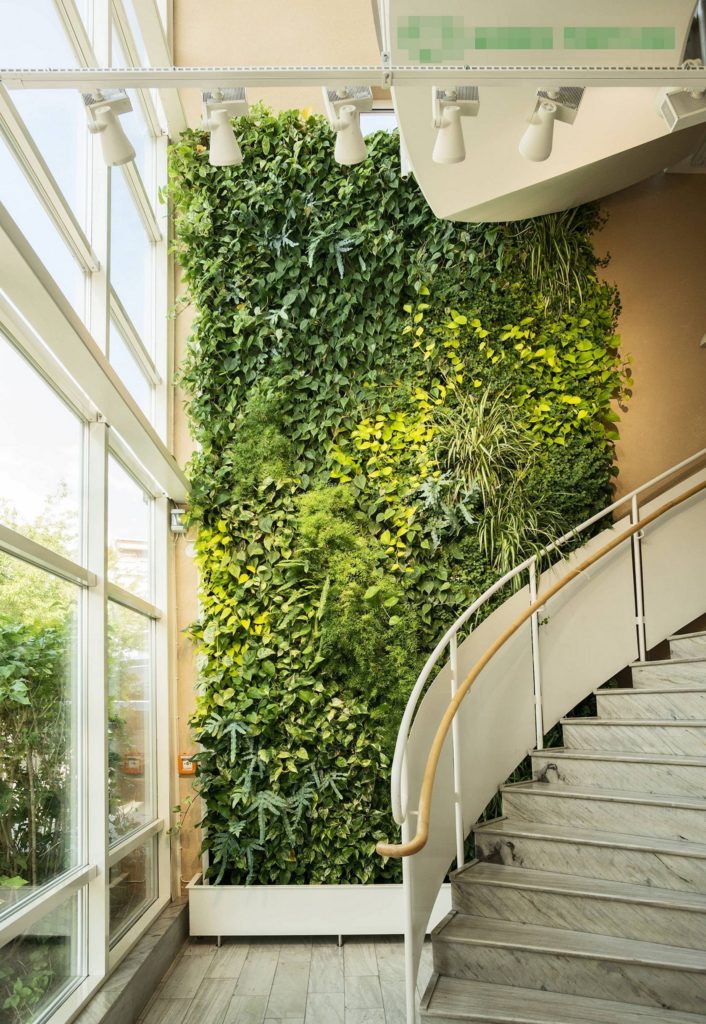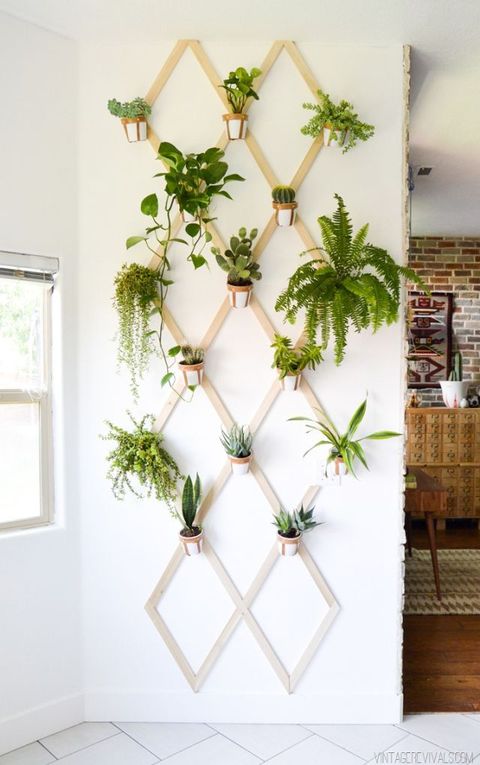Vertical gardens can transform indoor spaces into lush, green sanctuaries. They add beauty and freshness to any room.
Indoor vertical gardens are a wonderful way to bring nature inside. They save space, improve air quality, and create a calming atmosphere. Whether you live in a small apartment or a spacious home, vertical gardens offer a practical solution for plant lovers.
From simple DIY projects to elaborate designs, there are endless possibilities to explore. Imagine walls adorned with vibrant greenery or a cozy corner filled with cascading plants. Vertical gardens not only enhance aesthetics but also promote well-being. Ready to turn your indoor space into a green haven? Let’s dive into some creative vertical garden ideas that will inspire you to start your own indoor jungle.
Benefits Of Vertical Gardens
Vertical gardens offer a unique way to bring nature indoors. They are perfect for people with limited space. But, their benefits extend beyond just saving space. Vertical gardens can transform any room into a lush, green haven. Let’s explore some key benefits of having a vertical garden inside your home.
Enhancing Aesthetics
Vertical gardens add beauty to any room. They provide a natural focal point. Lush green walls can make a space feel more vibrant. You can choose from a variety of plants. Mix and match colors and textures for a stunning effect. A well-designed vertical garden can transform plain walls. It brings life and charm to your interiors.
Improving Air Quality
Indoor plants help clean the air. Vertical gardens can improve air quality. They absorb carbon dioxide and release oxygen. Some plants can also remove toxins. Cleaner air means a healthier living space. You’ll feel more refreshed and energized. Vertical gardens make your home healthier and more pleasant.
Choosing The Right Plants
Creating a vertical garden indoors is a great way to add greenery to your home. But choosing the right plants for your vertical garden is crucial. Different plants have different needs. Some thrive in low light, while others need high humidity. Let’s explore which plants are best for your indoor vertical garden.
Low-light Plants
Not all indoor spaces get plenty of sunlight. Low-light plants are perfect for such areas. These plants thrive even with minimal sunlight.
- Snake Plant: Also known as Sansevieria, this plant can grow in low light. It’s also very low-maintenance.
- Pothos: Pothos is another excellent choice. It can adapt to various light conditions, including low light.
- ZZ Plant: The ZZ plant is nearly indestructible. It needs very little light and water to survive.
High-humidity Plants
Some plants love moisture. High-humidity plants are perfect for bathrooms or kitchens. These areas usually have higher humidity levels.
- Boston Fern: This plant loves high humidity. Keep its soil moist for the best results.
- Spider Plant: Spider plants thrive in humid conditions. They are also very easy to care for.
- Peace Lily: Peace lilies enjoy humid environments. They also help purify the air.
Choosing the right plants is essential for a thriving indoor vertical garden. Whether you have low-light or high-humidity areas, there’s a plant for you. Happy gardening!
Diy Vertical Garden Projects
Creating your own vertical garden indoors can be a fun and rewarding project. Not only does it add greenery to your space, but it also helps purify the air. You can start with simple DIY vertical garden projects that suit your style and space. Below, we explore two exciting ideas: wall-mounted planters and hanging gardens.
Wall-mounted Planters
Wall-mounted planters are perfect for small spaces. They allow you to grow a variety of plants without taking up floor space. You can use wooden pallets, old picture frames, or even shoe organizers to create your planters.
Materials you will need:
- Wooden pallet or old frame
- Small pots or planters
- Screws and nails
- Soil and plants
Steps:
- Mount the pallet or frame on your wall.
- Attach small pots to the pallet or frame.
- Fill the pots with soil and your choice of plants.
- Water the plants as needed.
This setup is great for herbs, small flowers, or succulents. It keeps your plants within reach and makes watering easy.
Hanging Gardens
Hanging gardens are another excellent option for indoor vertical gardening. They can be hung from the ceiling or mounted on walls. This method is perfect for trailing plants or vines.
Materials you will need:
- Hanging pots or baskets
- Strong hooks or brackets
- Chain or rope
- Soil and plants
Steps:
- Install hooks or brackets on the ceiling or wall.
- Attach chains or ropes to the pots or baskets.
- Hang the pots from the hooks or brackets.
- Fill the pots with soil and plants.
- Water the plants regularly.
Hanging gardens can add a dynamic look to your home. They are ideal for ferns, ivy, or other trailing plants.
Both wall-mounted planters and hanging gardens can transform your indoor space into a lush, green haven. These DIY projects are easy to start and maintain, making them perfect for beginners.

Credit: twillyandfig.com
Space-saving Solutions
Indoor vertical gardens are perfect for those who want greenery but lack space. These gardens are ideal for small apartments and office spaces. Let’s explore some creative ideas for these environments.
Small Apartments
Living in a small apartment can feel cramped. Vertical gardens offer a solution. By utilizing vertical space, you can add plants without taking up valuable floor area.
Consider these options:
- Hanging Planters: Suspend them from the ceiling to save floor space.
- Wall-Mounted Shelves: Install shelves to hold your plants. They create a green wall effect.
- Vertical Pallet Garden: Use an old pallet, fix it to the wall, and fill it with plants.
Office Spaces
Offices can feel dull without plants. Vertical gardens can liven up the space. They improve air quality and enhance productivity.
Here are some practical ideas:
- Modular Plant Walls: These are easy to install and can be rearranged. They fit any office layout.
- Desk Dividers: Use vertical planters as desk dividers. They provide privacy and greenery.
- Corner Shelves: Add corner shelves to hold small plants. Utilize every inch of space.
Vertical gardens are versatile. They fit any space, big or small. Start creating your indoor green oasis today!
Maintenance Tips
Maintaining an indoor vertical garden is essential to ensure your plants remain healthy and vibrant. Proper care can also help your garden last longer and look more attractive. Below are some important tips to follow.
Watering Techniques
Watering is crucial for the health of your vertical garden. It is important to provide adequate moisture without overwatering. Here are some tips:
- Use a watering can with a long spout to reach higher plants.
- Water at the base of the plants to avoid wetting the leaves.
- Check the soil moisture regularly to avoid dry or soggy soil.
- Consider using a drip irrigation system for consistent watering.
Proper watering can prevent root rot and other water-related issues.
Pruning And Trimming
Pruning and trimming are essential for the health and aesthetics of your indoor vertical garden. Here are some best practices:
- Remove dead or yellowing leaves to encourage new growth.
- Trim overgrown plants to maintain a neat appearance.
- Use clean, sharp scissors to avoid damaging the plants.
- Regularly check for pests and remove any infected leaves.
Pruning and trimming can help your plants grow more vigorously and look more appealing.

Credit: www.fnp.com
Decorative Ideas
Vertical gardens are a wonderful way to bring nature indoors. They can transform any space into a lush, green oasis. But how can you make your indoor vertical garden stand out? The answer lies in decorative ideas. With the right touch, your garden will not only thrive but also become a beautiful art piece. Let’s explore some creative ways to decorate your vertical garden.
Artistic Arrangements
Create eye-catching designs with your plant arrangements. Think of your vertical garden as a canvas. Arrange plants in patterns or shapes. You can form circles, waves, or even a heart. Use trailing plants to create flowing lines. Mix tall plants with shorter ones for depth. This approach adds a dynamic, artistic flair to your indoor space.
Using Colorful Pots
Brighten up your vertical garden with colorful pots. Choose pots in vibrant hues like red, yellow, or blue. These colors contrast beautifully with green foliage. You can also mix and match different pot sizes. This creates visual interest and breaks the monotony. Ensure the pots complement your room’s decor. This way, your garden blends seamlessly with its surroundings.
Incorporating Technology
Incorporating technology into your vertical garden can make it easier to maintain. Advanced systems can take care of watering and light needs. This allows you to enjoy your plants without daily upkeep.
Self-watering Systems
Self-watering systems are a great addition to your indoor vertical garden. These systems use sensors to detect soil moisture levels. When the soil is dry, the system adds water. This ensures your plants get the right amount of water. It prevents overwatering and underwatering. Your plants stay healthy and vibrant with minimal effort.
Smart Garden Devices
Smart garden devices take plant care to the next level. These devices monitor light, temperature, and humidity. They provide real-time data to your smartphone. You can adjust settings to create the perfect environment for your plants. This technology helps you understand your plants’ needs better. Your vertical garden will thrive with the right conditions.
Common Mistakes To Avoid
Creating a vertical garden indoors can be rewarding and beautiful. But, it’s easy to make mistakes. Knowing the common pitfalls can help you avoid them and keep your indoor garden thriving. Let’s discuss some of the most common mistakes to avoid.
Overwatering Issues
Overwatering is a common problem with indoor vertical gardens. Plants need water, but too much can harm them.
Here are some tips to avoid overwatering:
- Check the soil moisture before watering.
- Use pots with drainage holes.
- Water plants only when the top inch of soil is dry.
Overwatering can lead to root rot and other diseases. It’s crucial to find the right balance. Monitor your plants regularly to ensure they are getting the right amount of water.
Improper Plant Selection
Choosing the wrong plants for your indoor vertical garden can lead to poor growth and disappointment. Select plants that thrive in indoor conditions.
Consider the following:
- Light requirements: Some plants need bright light, while others do well in low light.
- Humidity levels: Some plants prefer high humidity, while others need dry conditions.
- Growth habits: Choose plants that grow well vertically and fit the space.
Here’s a table of common indoor plants and their needs:
| Plant | Light | Water | Humidity |
|---|---|---|---|
| Spider Plant | Bright, indirect | Moderate | Average |
| Philodendron | Low to bright, indirect | Moderate | High |
| Succulents | Bright, direct | Low | Low |
By choosing the right plants, you can ensure your vertical garden flourishes. Research each plant’s needs and create an environment where they can thrive.

Credit: www.pinterest.com
Frequently Asked Questions
What Are Vertical Gardens?
Vertical gardens are space-saving garden systems. They use vertical space for growing plants indoors. They can be mounted on walls or freestanding.
How To Start An Indoor Vertical Garden?
Start by choosing a location with good light. Select appropriate plants and use vertical planters. Ensure proper watering and maintenance.
Which Plants Are Best For Vertical Gardens?
Best plants include herbs, succulents, ferns, and small flowering plants. They thrive in vertical garden setups.
How To Maintain Indoor Vertical Gardens?
Maintain by regular watering and trimming. Ensure proper light and humidity levels. Check for pests and diseases regularly.
Conclusion
Creating an indoor vertical garden is a rewarding project. It enhances your home’s aesthetics and purifies the air. You can start small with easy plants like herbs. Gradually, experiment with more varieties. Remember to consider light and watering needs. Use creative containers and shelves.
Enjoy the process and watch your garden thrive. Your indoor space will feel more vibrant and fresh. Happy gardening!



